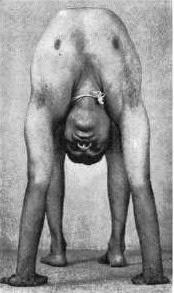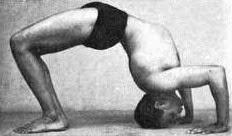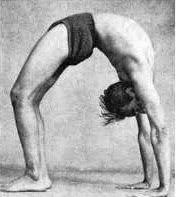
B.K.S. Iyengar in Upward-Facing Bow
Q: I have a shoulder impingement with a possible tear in the supraspinatus muscle. I also have arthritis in the AC joint. I tried chair version of Urdhva Dhanurasana Sunday but I could not raise myself up. Question: Which muscles of the shoulder and back are used to raise up the torso and straighten the arms in Urdhva Dhanurasana? Is there a way to strengthen those muscles with resistance training?A: First, I’d like to say there is a common misconception that getting into Upward-Facing Bow pose (Urdva Dhanurasana) is all about using the strength of your arms. In fact, your legs—which are stronger than your arms—play a crucial role in helping you move into the pose, and you should actually initiate your movement into the pose from your feet rather than your hands. I’ll be describing the action of your legs and feet in this pose in a future post, but until then because our reader asked specifically about the role of the arms in Urdva Dhanurasana, I’m going address just the movement of the upper body in this pose.
Next, I'd like to caution our reader that the combination of a possible supraspinatus tear and shoulder impingement (I am assuming on one side only), along with arthritis in the acromio-clavicular joint (between the acromion process—part of the shoulder blade—and the lateral end of the collar bone (again, I am assuming on the same side as the other issues), makes for one potentially limited shoulder and arm! If he has not had an MRI yet, this would help our reader clarify the question regarding a torn supraspinatus.But let me break each aspect of these shoulder difficulties down:Shoulder Impingement. Most of the time, the thing getting impinged or pinched beneath the AC joint (the one in our reader’s shoulder that also has arthritis in it) is the tendon of the supraspinatus muscle. This muscle is one of the four rotator cuff muscles. It starts off in the valley-like trough at the top part of the back of the shoulder blade, and the tendon travels laterally toward the upper arm bone, goes through a tunnel created by the AC joint, and attaches to the upper outer humerus bone. The primary job of supraspinatus is to help the ligaments of the shoulder area in keeping the humerus bone close to the part of the shoulder blade that makes up the shoulder joint (technically called the gleno-humeral joint). It turns out the ligaments don’t do a great job with this on their own, so the four rotator cuff muscles assist. The supraspinatus muscle also helps to swing the arm bone out the side and overhead with a group of other muscles, including the lateral part of the deltoid muscle, parts of the pectoralis major muscle, and the upper and lower parts of the trapezius muscle. The tearing of this muscle and the pinching often go hand-in-hand. (I discussed rotator cuff injuries briefly discussed in a past blog post Friday Q&A: Rotator Cuff Pain.)Shoulder Arthritis. I wrote about shoulder arthritis way back in 2012 (for a quick review, see Arthritis of the Shoulder and Yoga). An important thing to remember about arthritic joints: if they are inflamed and painful already, doing weight-bearing poses can make them angrier—can you say Upward-Facing Bow? So non-weight-bearing range of motion exercises might precede the recommendations later in this post. With all of that in mind, let’s tackle the first of the two questions our reader is curious about: Which muscles of the shoulders and back are used to raise up the torso and straighten the arms in Urdhva Dhanurasana?To set up for this pose, a practitioner usually starts in Constructive Rest pose, with arms flexed at the elbow and palms on the floor just above the shoulders with the fingers pointing towards the shoulders.



Triceps. For straightening your elbows, the main muscle you need to use is your triceps, which starts at your shoulder blades and upper arm bones and travels down to attach on the back of the ulna bones just below your elbows. You can strengthen this muscle by moving repeatedly from full Push-Up pose (Chaturanga) back up into high Plank pose or from low Cobra pose (Bhujangasa) up to High Plank pose. You can also target this muscle group nicely with weight machines and free weight exercises.Other arm muscles. To get an idea of the muscles in your upper arms needed to get into the pose, stand in the middle of the room with your arms overhead, with elbows bent and palms facing the celing at the same level as your head. Now imagine balancing a tray on your hands and the top of your head, and then press press the imaginary tray straight up to the sky To make this action happen, all the muscles that upwardly rotate your shoulder blades, especially the upper and lower trapezius, along with anterior deltoid and parts of the pectoralis major need to contract strongly. This is the same movement you need to make to move from Constructive Rest position to Upward-Facing Bow pose.You could strengthen both your triceps and all the other muscles just mentioned by moving from Anna Forrest’s variation of Downward-Facing Dog pose, known as Turbo Dog, where your elbows are bent toward the floor about 30 degree, to full Downward-Facing Dog pose. Seated bench presses at the gym also target these muscles, but you need to keep your elbows and arms parallel through the movement (no elbows out to the sides!). Spinal muscles. To backbend the arch of your spine, you need to contract all of the muscles that line both sides of your spine on your back body. The largest muscle group needed for this action the erector spinae, which run from the base of your skull all the way down to the back of your pelvis. When you contract these multiple layers on both sides of your spine at the same time, you can achieve an even arch of your spine. A great way to use work these muscles is to lie on your belly with your arms stretched out in front of you on the floor. Inhale up into a Locust pose (Salabasana) variation, sometimes called Superman pose, and exhale down to the starting position. You can repeat this several times. With this movement, you are not only working the erector spinae, but you are also getting benefit for the arms as well.In answer to the question “Is there a way to strengthen those muscles with resistance training?” my suggestions above to strengthen the groups of muscles in question with yoga use the resistance of your own body weight in the poses. Of course, you can also employ resistance by using free weights or weight machines at your local gym. As long as these isolated strengthening exercises don’t aggravate our reader’s shoulder issues, he may find them helpful in achieving his asana goal. Keep in mind that in addition to strengthening the muscles that create the actions described above, successful completion of Upward-Facing Bow pose also requires stretching the muscles on your front of the body adequately. But that is a story for another post! Finally, I’d like to suggest you ask your yoga teacher to show you a different variation of Upward-Facing Bow pose. Instead of working with a chair (I’m assuming your feet are on the chair seat), try working with your hands on two slanted blocks that are against the wall. This variation can be helpful for people who are tight in the shoulder area, as requires less opening in the shoulders than the full pose while still allowing them to use the power of their legs to move into the pose.—BaxterSubscribe to YOGA FOR HEALTHY AGING by Email ° FollowYoga for Healthy Agingon Facebook

